Garth Tucker
I happened to take a walk in Hammersmith and had memories stirred.
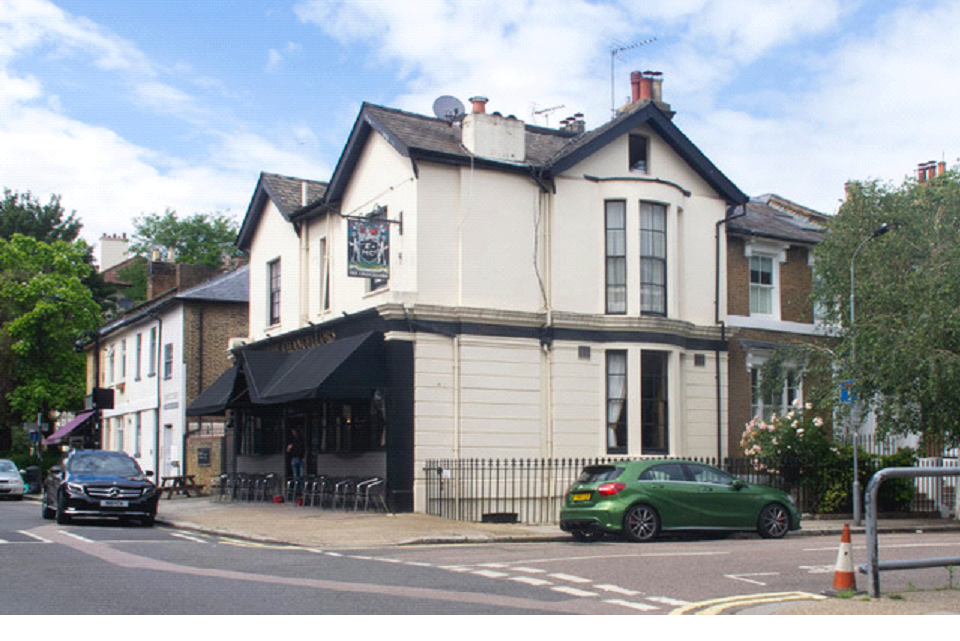
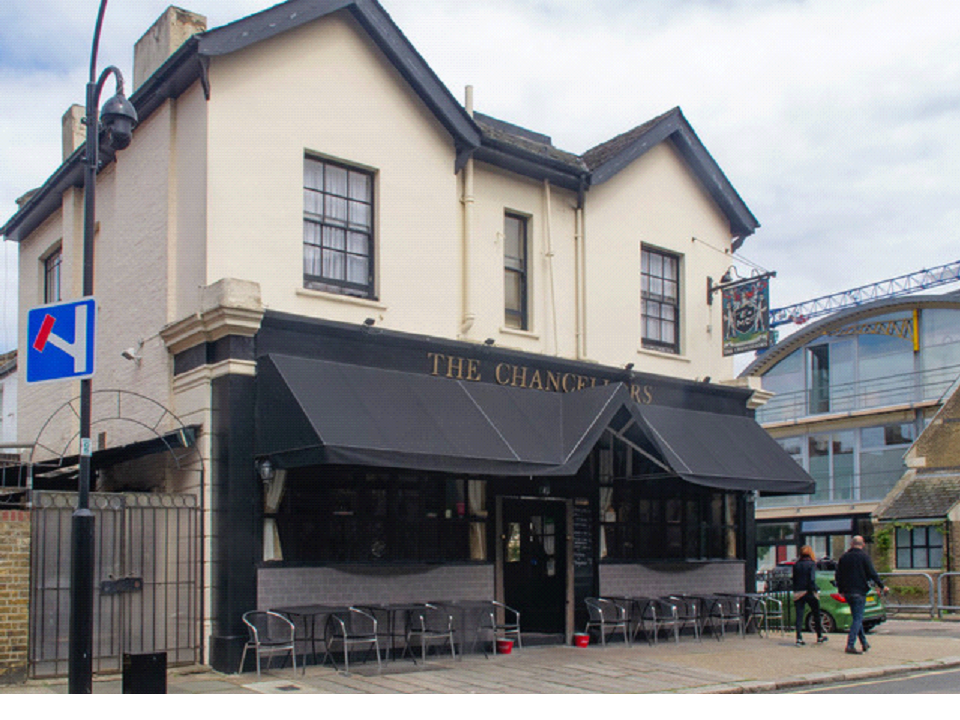
Pat Heigham
My favourite memory of The Chancellors (Studio 3 (R3)):
David Attenborough’s “Natural World” – there were lots of mute film footage that was thought worthwhile of which to make a few programmes. I was on Grams, doing my best to dub FX as the programme, with David, narrating live in the studio, was recorded to videotape (AMPEX in those days!). Afterwards, David offered us a drink in Studio 3! and as it was just after he had been given the job of Controller BBC2, I asked him how he felt about that.
“A great honour” he said, “but I’d rather make wildlife films”.
Which of course, he later returned to with spectacular success.
Mike Jordan
The Chancellors still has a good display of pictures of old BBC programmes made in Riverside and the lady there remembers us all visiting whilst doing “TFI Friday” back in the 1980s.
Before they did this to Riverside!
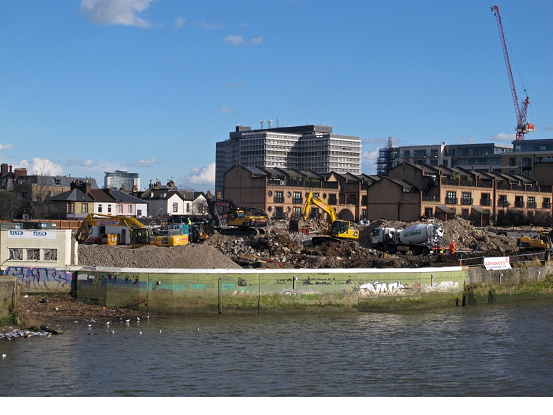
Dave Mundy
What a sad sight!
All those memorable programs for many years, even before the BBC got them.
We all cut our teeth on the Riverside training week to decide whether you should do cameras or sound! Laurie Duly and Keith Blair put us through our paces and we did all sorts of program exercises to determine where our skills (if any!) lay. I was told I should be a camera person, but having done three years in radio in Birmingham I really didn’t want to change horses!
Even after my BBC career I was still working there for Ch.4 doing “TFI Friday” with my OB Scanner and then TOTP when it moved down from Elstree.
The pictures of ‘The Chancellors’ brought back many happy memories of Studio R3 where we had a cable over the road and a phone on the end to tell us when we were needed to work, in the “Dr. Finlay” days!
Riverside recording studio (previously a dubbing suite) was a precursor to TMS in LG and was used to do the very first backing tracks for TOTP. I recorded the iconic “Sportsnight” signature tune there with Len Shorey and many other well-known pieces. The Studer C37 tape machines were unique in having editing scissors built in and a large lamp bulb inside the machine which I am still not quite sure what its function was!
Nick Ware
Len Shorey and many other well-known pieces? I can’t say I ever thought of him as a ‘piece’!
Who were the others? Ah, Pan’s People, no doubt!
The light bulb in the C37. I think that was used as a thermistor, effectively a variable load in series with the spooling motors. Later machines found better ways to do that.
Dave Mundy
Perhaps a comma in the right place would have separated Len Shorey from ‘other pieces’ (of music)!
Mike Giles
John Howell and I used a light bulb in series with a fan to adjust its speed. The bays in the World Cup studio in Mexico were tending to overheat, but the fan we had was too fast, so we tried bulbs of differing wattage to get the speed we wanted – not as scientific as the ballast resistor in the C37s, but it worked.
Dave Plowman
Ah – I thought it was to give a quicker start. Low resistance cold, so maximum current to the motor briefly. Then lights up, so higher resistance, and correct for the running current.
A car headlight bulb in series with a speaker used to be a crude way of protecting it for teenage parties.
John Howell
Another unscientific solution to a problem on that event concerned a certain senior member of the International Control Room staff abusing the bay talkback mic by yelling down it at great volume. This usually got the response from ICR in TVC of “back off the mic, Dave, we can’t understand what you’re saying” but in the heat of the moment he would forget!
So we clipped a Sony Personal mic inside the bay, about 12 Inches back from the existing mic which was then disconnected.
We didn’t tell anyone of this arrangement and there were no more problems.
Mike Giles
I also recall that in TC5, particularly for Campbell Ferguson’s benefit, at one time we used a foam windshield from a short gun on the TB mic, for much the same reason. Campbell’s particular problem, if I recall, was that much of the time he was moderately laid back and didn’t get close to the mic, but when the going got tough he felt the need to swallow it, so the system couldn’t cope with the very wide dynamic range.
Alec Bray
“… Riverside training week…” ?? Tell me more! I went straight from induction week at the Langham to Studio E and crew 7! I only ever wanted to be on cameras, although I did my time on sound (and looking back after all these years, I wonder if it was Mike Cotton who tried his best to induct me into mysteries of sound).
My memories of Riverside include “The Newcomers” and “Mogul” – but above all, those Practical Production Exercises for trainee directors. Oh and of course “Jackanory”, “Play School”, “Open House”, “The Idiot”, “Curtain of Fear” …
My most tricky track ever on a ped was on Play School in R2. It started as a medium 2-shot (or a wide shot) and ended up as a close-up on some jewellery in the presenter’s hand – and the tracking line was on a curve. R2 was the home for “PlaySchool”, and it was usually a joy to work on, I did not work on the first episode transmitted after BBC 2’s disastrous opening night, but I worked on the episodes for the following week (IIRC). Tricky production, “Play School”, especially the clock: zoom out, pan down zoom in (onto a different focal plane). “Jackanory” (R2)also had its moments, trying to line up a recalcitrant camera into the kaleidoscope for the opening and closing titles. R1 and R2 were put together for the Saturday Show “Open House” – one show memorable for me, trying to hold the camera still as I was trying not to laugh at Blaster Bates in an interview with Gay Byrne. Usually at this time, interviews took place on a rostrum, so that the cameras could more easily get level with the eyelines of presenter and interviewee: not so on “Open House”: to allow for as much floor space as possible, the interviews were done at studio floor level. To get the eyeline correct, the pedestal was full down and I was kneeling on the floor. I did not know who Blaster Bates was at the time. But the guy in the interview was talking about a shower of shit over Cheshire – and the stuck his hand into his jacket pocket, pulled out something about the size of a small marble and slammed it down onto the table in front of him. “There you go, “ he said, ”There’s enough gelignite there to blow the whole place to smithereens” (or similar).
The two studios were essentially vision mixed as one studio. Generally, one segment was rehearsed in one studio when the other was live – I remember dancers in R2. In R1, on another “Open House”, there was Millie with “My Boy Lollipop”. Other show had the “bongo trolley”(?) (a frame about six feet long, clamps at one end and a frame and canvas chair at the other) latched onto the front of the Mole crane, with the male singer – as I recall dressed in top hat and tails – sitting at the end. The shot that results is a medium close up of the performer – who is static in the frame – with the background whizzing behind him as the Mole crane chugs round the studio.The two studios were also put together for a performance of Michael Tippett’s “Concerto for Double String Orchestra.” I was tracking a Vinten Heron on the camera-right hand side of the orchestra in R1 (the orchestra was in two section mirrored left and right). The cameras from R2 were in the gallery and on the floor, recording our final run through. They also recorded the notes in the gallery after the final run through, where Michael Tippett was present. In fact, they were HIS notes: he asked, for example, the VM to mix shots rather than cut on at least one point. We had to modify our track at one point, as far as I recall. Then the two studios recorded the full performance. The final (edited) programme looked at the way the conductor wanted the camerawork and vision mixing to reflect what he was trying to achieve in the music. Of course, there was “The Idiot” (all but one episode in R1), which made a great impression on me personally. As a result, I got and read all of Dostoevsky’s novels. Another hugely enjoyable production from R1 (and which had Pat Heigham on Grams) was “Curtain of Fear” – a comedy thriller – which again involved me tracking into a close-up of the leading characters kissing. The director wanted a tight shot, but on transmission I went a bit too tight, and all you saw were four lips diagonally across the screen (4:3 ratio, of course!). On one episode, I was on a ped and there was one other camera looking at this particular scene. According to the script, we had to move from this set around to the next set – and in my case, I had to clear round a Mole Richardson sound boom as well. There was just one word to do this in the script – “No”! We asked the director, Gerry Blake, about this – he said, no it will be all right, he had worked it all out with matchboxes and string! However, boy!, that was some fast move! I am sure that the ped tipped up as I rounded the boom. IIRC, the next shot was into a telephone box – the iconic Gilbert-Scott type.Another production in R1 was “(The) Marriage Lines” with Richard Briars and Prunella Scales. I worked on this show after Riverside was converted to use Pye Mk5 cameras, sometime in the early 1960s. The main problem was that theses cameras had motorised turrets that were really incredibly slow to operate. On one “Marriage Lines” I had three consecutive shots of Richard Briars – MCU, CU and BCU, which were achieved by rotating the turret to select the appropriate lens. There was little time to do this, so as soon as the camera was cut away, finger on the lens change, rotate the camera focus and hope that the focus position was right as the lens swung into place. Luckily I managed it!, (And thanks to the Vision Mixer, too!) Another couple of programmes from R1 that I worked on were “Mogul” and “The Newcomers”. You can get involved in some programmes, such as “The Idiot”, mentioned above: “The Newcomers” was quite the opposite: I thought that it was a tedious programme to work on. I can’t say that I was there for the best years of Riverside: I am sure others have better stories.
Paul Victor
I well remember Riverside: “Dixon of Dock Green”, “Dr Finlay”, “Cafe Continental” and many more Oh ! for my lost diaries!
Alasdair Lawrance
I did several “Dr. Finlay”s cable bashing, as well as zooming through those windows, and it was years later I discovered that Andrew Cruikshank went to my old school, Aberdeen Grammar.
Dave Plowman
As did I. And remember him giving a talk to the school in the hall.
Bill Dudman
I remember shooting on 35mm film, multi camera ( Addavision) for a USA coproduction at Riverside sometime in 1970s.
Pat Heigham
Stories involving Riverside:
I recall in the 1960s working on “Melissa”, a Francis Durbridge serial mystery. We were only given the script for the final episode at the last possible moment, and warned against newspaper journalists ambushing us outside the studios, offering monetary bribes to reveal the outcome, so they could publish a ‘spoiler’!
I have a few more tales of Riverside, mostly to do with sessions in the music studio, which was the old film scoring stage. Initially the tape machines were BTR2s I think, the Studers came later. The little scissors fitted to the latter could be dangerous, as people who couldn’t kept their fingers off, used to wander in and say: “ What’s this do?” and press it!
I think there’s a sequence in Richard Cawston’s “This is the BBC”, involving set designers planning to build a canal set, filled with water. I have an idea the programme was a Riverside production.
Mike Jordan
Not similar to when (apparently) BBC put an ice rink in R1 for iceshows and took in a Kendal OB unit. (Ex KA folks to confirm). However unfortunately the rink melted and flooded the underfloor main power distribution cables.
Oh dear!
And wasn’t Riverside a really nice tidy area? or not?
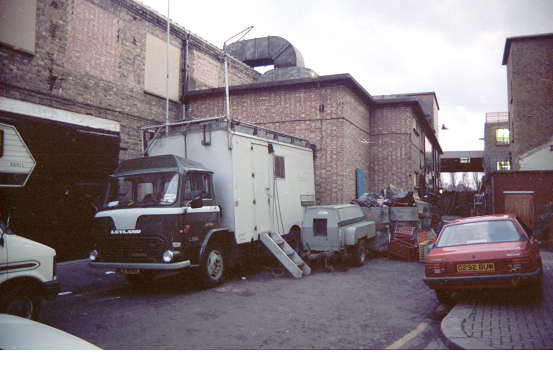
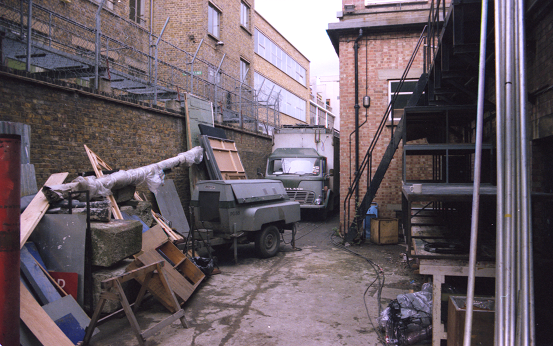
My first memories (as a non-tech ops person) was going down from BH Lines department in summer 1997 with a rack of equalisers and amps (GPA 4As of course) to equalise the GPO lines from the remote sites for the Boat Race when Riverside was the main site. Vans parked down that alley to the east side of the studios.
Then I was there several times over the years for the race when it was a camera site and boat receive site.
Finally, just after I had left the BBC, I was contracted back to be the EM for the BBC OB units covering “TFI Friday” and I was there most Fridays for about two and a half years latterly as the Ginger TV Unit Manager Scott Turnbull had been in an accident. That went on for me to be Unit Manager for The Priory at a studio (well shed actually) near Kings Cross.
I went in a couple of times after Planet TV from Bow (who were the original studio for Breakfast TV) had stripped out that site and moved everything to Riverside, making proper gallery in what was Chris’ studio and actually installing permanent VT as opposed to our BBC de-rig in a little room off the side passageway where I had organised an installation.
I still have some bits from Riverside including cue light boxes and his handheld mic ident! Ah memories (including the cafe across the road and The Chancellors).
John Howell
Although I was a studios bod I did a couple of days on “The Ice Show”, John Livingstone was the OB Sound Sup.
John Nottage
That’s jogged my memory: I did a series of “Ice Shows”, John Livingstone as SS, but it was from The Round House (Neasden?) – maybe 1969? I remember a few things from that show (I think!). We left everything rigged overnight and came in the next day to find a load of band mics missing: they even took some 4038s. After that, me took in all the mics heads. Next night they nicked the STC sockets from the top of some mic stands, presumably so they could connect to the 4038s they’d nicked. After that it was rig/derig the band each day! The other happier memory was the lovely Anita Harris turning up for a guest appearance: little skating skirt, lovely long legs and a great skater. Cheered everyone up immensely. Happy days…
John Howell
That’s brought further memories, wasn’t there a Reslo Ribbon mic on each table laid out in ‘nightclub’ fashion? how we managed the cables I can’t think!
Roger Bunce
Crew 16 outside the Chancellors, when it was Riverside 3.
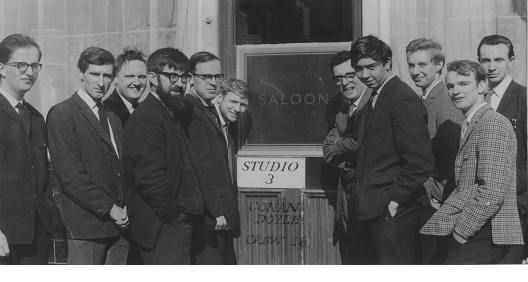
David Denness
That was the occasion of the last programme in a series of short stories by Sir Arthur Conan Doyle which were not Sherlock Holmes tales. A very fine series to work on. Photo taken by Dave Heddon, who was also on the crew but could not be in two places at once.
Geoff Hawkes
I recognise nearly all of them except the one leaning in centre left and the two on the right behind John (then Jim) Corby. I think the one far right maybe Eddy Brandon, though he usually had long hair when I knew him later.
Incidentally, they were all classically dressed with jackets and ties as we all did in the nineteen-sixties.
When was the watershed moment when it changed to jumpers and trousers or even jeans?
Len Shorey told me how Jem Whippey raised a few eyebrows when he turned up for his recruitment interview in casual dress, but they let him in and perhaps it was him who set the trend,
Vernon Dyer
At that time there were so many Johns; John Corby is JM Corby, hence ‘Jim’, and my first name is John so became known by my middle name.
Geoff Hawkes
Thanks for explaining why John Corby was known as Jim or “Jimbo”, though in later more dignified years when he rose to high office, he reverted to his given name of John.
At one time “Geoff” along with “Jeff” became the most common name.
I’m still not convinced that the person to the right of Dave Deness is Keith Bowden. Does anyone have confirmation of that, from the man himself perhaps? I don’t know the face to the right of Rod (Rob?) MacFarlane either.
“Vern” was definitely more distinctive than “John” and you weren’t the only one to go by your middle name. What do non-BBC people call you?
Vernon Dyer
I’m John to my family at home, but Vern[on] to anyone who met me from 1963 onwards, including my wife and her family.
John Howell (Hibou)
Righthand group: the late John Hays (SAI), Dave Denness, Keith Bowden, Jim Corby, and yes, Eddy Brandon.
It was Bob or Mac, possibly Rob, but never Rod McFarlane.
I had digs in Pennard Road W12 when I joined the Beeb, sharing a room with engineer John Bradley. In the other room were two guys in Film Recording. When they moved out Bob McFarlane and Peter Rose moved in, both are sadly no longer with us, Mac dying tragically from cancer at a very young 30 in 1973 and Peter who was Sound Supervisor on ‘The Antiques Roadshow’ among many other big shows passed away in 2012.
We didn’t last long in Pennard Road despite the Sunday lunches for 2/6 extra and moved to a flat in The Avenue West Ealing. We were eventually joined by Chris Wilden and Barry Austin.
David Newbitt
As John says, it was Bob or Mac, and I well remember the sense of unreality at the loss of a colleague so early in his life. The same ‘not quite being able to grasp it’ applied on the day when arriving to do TOTP we heard about poor Colin Charman.
Well before then, in the early 1960s another tragically premature loss was that of Brian Johns. I suspect not too many will have known him but he was on my first crew (Crew 8) when I joined and I knew him quite well. He accompanied me on a visit to my parents in Somerset for Christmas 1962, travelling down in his A40 Farina. As is now legendary, snow set in with a vengeance and we had to return early to London driving on snow chains the whole way. Southern England had lying snow for 62 consecutive days, since which time no spell has exceeded 10 days. During 1963 Brian fell ill and was soon unable to continue working. He died in early 1964.
Bernie Newnham
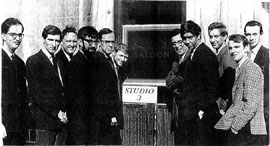
This picture is also elsewhere on the website – from about 2004. I think Dave may have the dates wrong for Brian Johns, because I’m pretty certain I knew him in 1966. I have an image in my head of him when we were leaving the Frithville gate heading for the Bush.
Dave Newbitt
Bernard is quite right – my memory date-wise is often wrong but not usually as badly wrong as in this case. Obviously I was right about the date re our Christmas snow experience but totally wrong with regard to Brian’s sad demise. I feel bad that my recollection has compressed the period of his illness in this way – it seems disrespectful and I wish I had delved a little deeper before mentioning it.
Having now checked I think the correct date was in the spring of 1968 when he was 27. Thank you for your gentle note of correction.
Robin Sutherland
I too well remember Brian Johns when I was a very junior oik on Crew19 in 1967. He was a lovely chap, very keen on flying and had a PPL. Everyone was stunned when he fell ill and passed away.
Geoff Fletcher
Wednesday 15th May 1968. According to my diary, I was working in TC3 on Dave Mutton’s Crew 14 doing Camera 6 on “The Detectives”. I wrote “Dick Greening told me about poor Brian Johns – very, very sad news”.
Garth Tucker
I remember Brian Johns passing with great sadness. He drank in my local pub in Burnham, Buckinghamshire, and was on my original TO Course at Evesham. He was largely responsible for a wicked film documentary which claimed Wood Norton was the site of nuclear strike facility.
Dave Mundy
Can I tell you all about how I got a copy of the picture.
The recently deceased John Hayes had a flat in High Wycombe, rented out to a ‘lady-of the night’, and he became her chauffeur.
One day she had a morning appointment in Fulham and as it was close to lunch time, having full-filled her duties, she asked John if there was anywhere to eat. He remembered ‘The Chancellors’ and took her there!
John saw the BBC pictures on the wall and asked the barman if he could get him a copy of the Crew 16 picture. I was working in Riverside every Thursday and Friday doing “TFI Friday” for Channel 4 in my OB Scanner, so ‘The Chancellors’ had become my local! (We even shot a sequence in the landlady’s apartment upstairs, the holy of holies! If you knew Bella you’d know what I mean, a lady made for Benidorm if ever there was one!).
Anyway, the barman told me about John’s visit so I asked him to get me a copy as well. He gave me John’s contact details so when the copies has been done I rang John (who lived in Great Missenden at the time), and he was most surprised that I knew about his request! I invited him to my Thursday meeting pub in Lacey Green and I gave him his copy.
I was pleased to see it on a picture board in his house when I attended his funeral recently.
What a long tail our cat’s got, as my Mother used to say!
Roger Bunce
Last time I visited Riverside, for the “Playschool” reunion, just before it was demolished, The Chancellors had lost its charm. Only a few of the old photos remained on the walls. But now Riverside is reopening as studios, maybe it’ll become a show-biz watering hole, once again.
Peter Neill
But Riverside is being rebuilt as — wait for it — studios!
Bernie Newnham
Albert Barber, Chairman of the BBC Pensioners Association, is in conversation with the management of Riverside, talking about commemorative stuff. They are looking for people with memories of the olden days to talk about them. I have to say that the most I did at Riverside was zoom through the round window – though I also remember watching Yehudi Menuhin play in a pool of light in the middle of R1, and in that same R1 seeing the leaking roof dripping into a bucket in the middle of the Tannochbrae pub. Daniel Thurman at Riverside sent this to the BBCPA – “…As you are very aware, Riverside Studios has been undergoing redevelopment since 2014 and we are due to reopen on our original site late this year. In 2017 I applied for and won funding from the National Lottery Heritage Fund to ensure the conservation and activation of Riverside’s archive. This will include two full-time heritage staff, on site archive storage for our collection and a programme of community events. One element is a short (1.5-3 minute) ‘heritage reel’ which will play ahead of film screenings in our 200-cinema and 46-screening room. As well as celebrating Riverside’s 40+ years as an arts centre, we are keen for this film to reference the site’s early history – as a Victorian iron foundry, film studio (1933-54) and 20-years as a BBC facility (1954-74). With that in mind, we would be thrilled to have a crew member who worked at Riverside Studios participate in that film, recalling their relationship with the building. We would like participants to respond to a particular historic object (eg. photographs, technical equipment, posters…), so they shouldn’t worry if specific memories don’t immediately leap to mind. We aim to take up as little of their time as possible and for the experience to be informal and undemanding… “
Maurice Fleisher
You might be interested to know I have a copy of the British magazine “Architectural Design” from February 1957, Price 3/6. As cameraman I personally did many shows from Riverside, and the front cover of this edition shows a small photo of me on camera looking at actor Mervyn Johns plus others in a crime drama from R1. However the main interest is the fact that a large section of the magazine covers TV Studio design (of the time, B/W of course) including quite comprehensive coverage of Riverside studios and all associated areas of the building, control rooms, lighting grid, canteens, etc. (although no mention of Riverside 3…..the pub opposite). Other studio centres in the UK and other countries are also included.
Dave Newbitt
There have been many fond memories posted about The Chancellors, and I wonder if there are any similar sentiments regarding the pub along the riverbank just West of Hammersmith Bridge? I think it was the Blue Anchor and to stroll there from R1/R2 for lunchtime on a summer’s day sticks in my memory as an example of how pleasant life at the Beeb could be in the 1960s and 1970s.
I recall once walking there in a group which included Dave Hughes. We were overtaken by two young ladies with irresistible derrières that significantly lifted his spirits, prompting him to observe “I always thought I was a tit man”. I could see what he meant!
Graeme Wall
The Blue Anchor is the one I remember going to and occasionally The Dove, a bit further west. I don’t remember going to The Chancellors at all, maybe that wasn’t a Crew 3 pub.
Dave Beer
I have fond memories of my first day at the Beeb following the months of induction at Evesham, (TO 25). I was tracking the Heron on “Jackanory” auditions at Riverside and when lunch came, the crew (I can’t remember which now), announced that we would head along river to The Blue Anchor for some liquid refreshment. I couldn’t help thinking this TV business can’t be too bad!
Vernon Dyer
I remember going for lunch along the river walk, past The Blue Anchor — I seem to recall it was called The Rutland, but as we all know, it was a very long time ago.
Google Street view – The Blue Anchor, The Rutland Arms, and further on The Dove, all still there and still with the same names, quite a rarity for pubs these days.
Nick Ware
I used to spend those long lunch breaks nipping up to Henry’s Radio in Edgware Road to get ‘bits’ for whatever the latest project was. Either that or Useekia’s to get metal chassis parts guillotined and folded – or Fay’s Metals for sheet metal, or Allscrews – I could go on. Didn’t always get back on time, but at least when I did I was sober!
And I have vivid memories of building a wall of TR90s around myself in R1 to fend off V.L.’s advances! Slight change of attitude though a few years later when I found myself working freelance for her at her neatly named prod company: Cinema Verity.

If you Google her you’ll find a pic of her posing by a TR90 in that very same control room.
Geoff Fletcher
Going to check my diaries for Blue Anchor and Chancellor references. Lots of memories of Riverside – including when I was on my Inlay attachment, struggling with the antiquated kit in the galleries!



